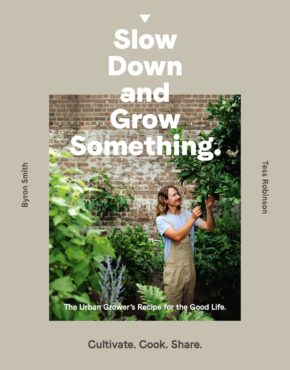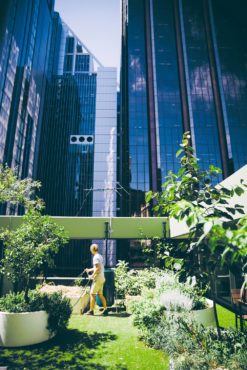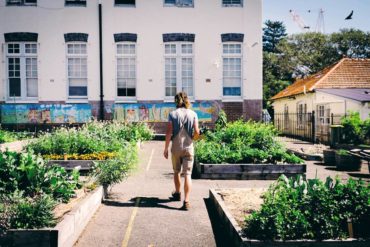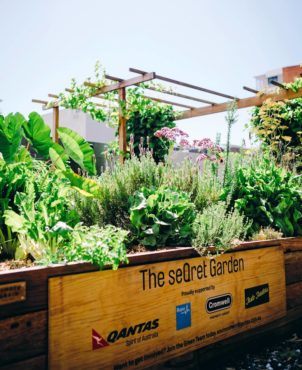 Editor’s note: This is an excerpt adapted from Byron Smith’s book, “Slow Down and Grow Something: The Urban Grower’s Recipe for Good Life,” recently published by Murdoch Books.
Editor’s note: This is an excerpt adapted from Byron Smith’s book, “Slow Down and Grow Something: The Urban Grower’s Recipe for Good Life,” recently published by Murdoch Books.
Plants have naturally adapted to the climate in which they have evolved — that’s why the plants in your local national park aren’t expecting you to appear with a watering can any time soon. The same goes for older, established gardens with shade trees, perennial shrubs and other hardy ground covers — they only need the occasional watering through summer or in times of drought.
On the other hand, your precious basil seedlings or freshly potted lemon verbena will need some extra TLC. A veggie patch requires more water than an ornamental garden, so choose a watering system that suits your garden size, your plant types and the time you can spend watering — this will help you get the best results.
If you’re working long hours or are likely to go away frequently, an irrigation system will be your best friend. If you’re around home a little more, a good hand-watering session every two or three days will be perfect — and you might just find it becomes your relaxation time.
Once you understand how water, soil and plants interact, you’ll be growing some quality, juicy produce in no time — and I’m sure your indoor plants will benefit from your new-found knowledge, too.
Watering Methods
The first thing we need to do is to look at the various ways you can give your green friends a drink.
Watering can: This method is useful for plants that are located where the hose can’t reach. You can add concentrated liquid fertilizer, fish emulsion, seaweed extract or worm juice to the watering can, to water in new seedlings or over foliage.
 Hose: Buy the best hose you can afford and attach it to the wall in whatever way suits your ability and space. Before using your hose, stretch it out and weigh down the two ends with some timber or bricks. Leave it like this for a day, and you shouldn’t get any annoying kinks in your hose.
Hose: Buy the best hose you can afford and attach it to the wall in whatever way suits your ability and space. Before using your hose, stretch it out and weigh down the two ends with some timber or bricks. Leave it like this for a day, and you shouldn’t get any annoying kinks in your hose.
Lastly, make sure you buy a quality trigger nozzle for the end. One with a jet and shower option is fine. Watering the garden is a time to relax, appreciate your plants and admire your hard work, so don’t let a dodgy hose put a dampener on this experience.
Automatic irrigation: These systems take time and some initial cost to install, but they ensure that your garden receives a reliable amount of water at all times. A good system can effectively water your lawn, garden beds, pots, green roofs, planter boxes and any hard-to-reach places.
Drip irrigation lines can be strategically placed under mulch so the water quickly enters the soil and reaches the roots directly, reducing evaporation. To be more water-wise, you can connect your irrigation system to a water tank.
Rainfall: Not surprisingly, this is the best form of water as it’s natural and contains a small amount of nitrogen that plants love. Rainwater is drawn through the tiny holes (stomata) in plants’ leaves, stimulating larger leaf growth.
If you’re growing leafy greens, try to combine any drip irrigation system with some overhead watering from the garden hose or watering can at least once a week. It’s always a good idea to take your indoor plants outside for an invigorating shower when it rains.
 Going Deeper
Going Deeper
As a self-confessed plant whisperer, I am acutely aware if a plant is thirsty or has sadly died from lack of water, but I realise that many novice gardeners are unable to tell the difference. Can you?
Following is an experiment you can try to see what a water-stressed or wilting plant really looks like. This will help you identify the symptoms, should they arise in the future.
Plants obtain water through their roots and leaves, and lose it through their leaves via transpiration — which is part of the photosynthesis process. Like the carriages on a train, water molecules continuously tow each other from the soil to the top of the plant by cohesion. As a gardener, your responsibility is to make sure the train doesn’t stop.
Here’s your experiment (you’ve got to be cruel to be kind sometimes!):
- Buy two of the same plant in small pots. Ideally, try a tomato, chilli or basil. Place the pots in the location you plan to grow the plant and water one plant but not the other.
- Observe and compare how the leaves start to wilt when the plant transpires faster than it can absorb water. Tomatoes will temporarily wilt as a way of reducing the leaf face exposed to the sun, but they will bounce back during the night when the transpiration rate is less than the absorption rate.
- If the plant cannot replace the transpired water at night from the soil, then it has reached permanent wilting point — it’s basically flatlining.
- It’s OK if your plants wilt a little during a hot day, as this tough love encourages deeper root growth. But for better eating and good plant mass, you should generally keep your edibles well watered so they remain happy and unstressed.
No Excuses!
There are many water-related excuses for the “passive euthanasia” of plants.
“It wasn’t my job to water/my friend forgot to water/I swear I watered them …”
Although watering needs to be a certain person’s gig, to prevent underwatering AND overwatering, all people in your household should be conscious of the plants’ needs. It’s just like keeping your pet’s bowl full of water.
 “But I usually give it half a glass of water when I walk past it.”
“But I usually give it half a glass of water when I walk past it.”
A good soaking less often is better than just wetting the surface frequently. The roots of the plant will grow stronger and penetrate deeper into the soil to follow the water rather than sitting just under the surface. Ensure that the water flows out from the holes in the base of the pot to maintain good soil moisture.
“The potting mix looked dry, so I watered it, but the water instantly flowed straight to the base of the pot.”
This is usually because the soil has become hydrophobic, meaning that the water pools on top and runs down between the pot sides and the soil rather than through the soil. If you notice this happening, repot the plant with new mix or add organic matter to the mix to improve soil structure. To stop it from happening in the first place, always use premium soil mixes and never let a soil dry out completely.
“When I hose the garden, I don’t know if the soil underneath the mulch is actually getting any water.”
Check that your mulch isn’t too thick. Hay should be 8–12 inches thick; sugarcane should be (¾–1 inch) thick. Ruffle up the mulch with your hands if it seems a bit flat and water repellent. As you’re watering, every few minutes or so perform an intermittent check by removing a patch of mulch to see if the soil is getting soaked underneath.
How long you should water for depends on the season, soil type and plant type, including its stage of growth. A good rule of thumb is to water until you see pooling on top of the soil or until you can drive your finger into the soil and feel that it is moist to a depth of at least 4 inches.
 “I didn’t realize the batteries for the automatic irrigation system had died.”
“I didn’t realize the batteries for the automatic irrigation system had died.”
A common problem with irrigation systems is that you aren’t as “connected” to the garden as you think. Because you don’t physically water them yourself, it’s easy to forget about your plants.
Remember, irrigation systems have their flaws, too, and they need to be maintained just like anything else. They’re a good backup to have, as long as you’re still spending time in the garden.
“All the plants get the same amount of water, but my lavender looks moldy and sick.”
Know your individual plants’ watering needs. Allow your plants to use the water in the soil before adding more, as this helps create a stronger plant with deeper roots. Smaller pots tend to dry out more quickly, whereas larger, deeper pots hold water for longer.
If your plants are going to be exposed to sun all day long, go for bigger pots to allow for more water absorption. If plants are in morning sun only, in the shade or even kept indoors, they won’t dry out as fast so can be in smaller pots.
Keep your pots slightly raised on feet or plastic building packers/shims to allow free draining of water — this is crucial to prevent waterlogging.
“But I had a self-watering pot.”
Self-watering pots were made so that we could be lazier gardeners. The reason your plants won’t dry out is because they’re wallowing in a pool of stagnant water. The downside to this is that they’ll have less oxygen around the root zone, therefore stunting their growth. Saucers under pots should be there to catch water, not be used as water reservoirs.





























